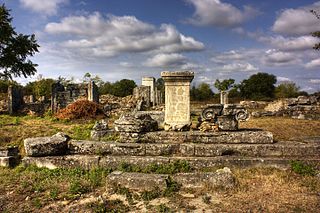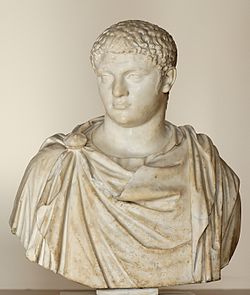Geta - Roman Caesar: 198-209 A.D. - Roman Emperor : 209-211 A.D. --
Bronze 17mm (3.19 grams) of Nicopolis ad Istrum in Moesia Inferior
Bare-headed, draped and cuirassed bust right.
NIKOΠOΛI ΠPOC ICTP, Tyche standing left, holding rudder and cornucopia. You are bidding on the exact item pictured, provided with a Certificate of Authenticity and Lifetime Guarantee of Authenticity.
The cornucopia (from Latin cornu copiae) or horn of plenty is a symbol of abundance and nourishment, commonly a large horn-shaped container overflowing with produce, flowers, nuts, other edibles, or wealth in some form. Originating in classical antiquity , it has continued as a symbol in Western art , and it is particularly associated with the Thanksgiving holiday in North America .  Allegorical depiction of the Roman goddess Abundantia with a cornucopia, by Rubens (ca. 1630) In MythologyMythology offers multiple explanations of the origin of the cornucopia. One of the best-known involves the birth and nurturance of the infant Zeus, who had to be hidden from his devouring father Cronus . In a cave on Mount Ida on the island of Crete , baby Zeus was cared for and protected by a number of divine attendants, including the goat Amalthea ("Nourishing Goddess"), who fed him with her milk. The suckling future king of the gods had unusual abilities and strength, and in playing with his nursemaid accidentally broke off one of her horns , which then had the divine power to provide unending nourishment, as the foster mother had to the god. In another myth, the cornucopia was created when Heracles (Roman Hercules ) wrestled with the river god Achelous and wrenched off one of his horns; river gods were sometimes depicted as horned. This version is represented in the Achelous and Hercules mural painting by the American Regionalist artist Thomas Hart Benton . The cornucopia became the attribute of several Greek and Roman deities , particularly those associated with the harvest, prosperity, or spiritual abundance, such as personifications of Earth (Gaia or Terra ); the child Plutus , god of riches and son of the grain goddess Demeter ; the nymph Maia ; and Fortuna , the goddess of luck, who had the power to grant prosperity. In Roman Imperial cult , abstract Roman deities who fostered peace (pax Romana) and prosperity were also depicted with a cornucopia, including Abundantia , "Abundance" personified, and Annona , goddess of the grain supply to the city of Rome . Pluto , the classical ruler of the underworld in the mystery religions , was a giver of agricultural, mineral and spiritual wealth, and in art often holds a cornucopia to distinguish him from the gloomier Hades , who holds a drinking horn instead. Modern depictionsIn modern depictions, the cornucopia is typically a hollow, horn-shaped wicker basket filled with various kinds of festive fruit and vegetables . In North America, the cornucopia has come to be associated with Thanksgiving and the harvest. Cornucopia is also the name of the annual November Wine and Food celebration in Whistler , British Columbia, Canada. Two cornucopias are seen in the flag and state seal of Idaho . The Great Seal of North Carolina depicts Liberty standing and Plenty holding a cornucopia. The coat of arms of Colombia , Panama , Peru and Venezuela , and the Coat of Arms of the State of Victoria, Australia , also feature the cornucopia, symbolising prosperity. The horn of plenty is used on body art and at Halloween, as it is a symbol of fertility, fortune and abundance. Base of a statue of
Louis XV of France
Tyche (Greek for luck; the Roman equivalent was Fortuna ) was the presiding tutelary deity that governed the fortune and prosperity of a city, its destiny. Increasingly during the Hellenistic period, cities had their own specific iconic version of Tyche, wearing a mural crown (a crown like the walls of the city).
 The Greek historian Polybius believed that when no cause can be discovered to events such as floods, droughts, frosts or even in politics, then the cause of these events may be fairly attributed to Tyche. The Greek historian Polybius believed that when no cause can be discovered to events such as floods, droughts, frosts or even in politics, then the cause of these events may be fairly attributed to Tyche. Stylianos Spyridakis concisely expressed Tyche's appeal in a Hellenistic world of arbitrary violence and unmeaning reverses: "In the turbulent years of the Epigoni of Alexander , an awareness of the instability of human affairs led people to believe that Tyche, the blind mistress of Fortune, governed mankind with an inconstancy which explained the vicissitudes of the time." In literature, she might be given various genealogies, as a daughter of Hermes and Aphrodite , or considered as one of the Oceanids , daughters of Oceanus and Tethys , or of Zeus. She was connected with Nemesis and Agathos Daimon ("good spirit"). She was uniquely venerated at Itanos in Crete, as Tyche Protogeneia, linked with the Athenian Protogeneia ("firstborn"), daughter of Erechtheus , whose self-sacrifice saved the city. She had temples at Caesarea Maritima , Antioch , Alexandria and Constantinople . In Alexandria the Tychaeon, the temple of Tyche, was described by Libanius as one of the most magnificent of the entire Hellenistic world. Tyche appears on many coins of the Hellenistic period in the three centuries before the Christian era, especially from cities in the Aegean. Unpredictable turns of fortune drive the complicated plotlines of Hellenistic romances , such as Leucippe and Clitophon or Daphnis and Chloe . She experienced a resurgence in another era of uneasy change, the final days of publicly sanctioned Paganism , between the late-fourth-century emperors Julian and Theodosius I who definitively closed the temples. The effectiveness of her capricious power even achieved respectability in philosophical circles during that generation, though among poets it was a commonplace to revile her for a fickle harlot. In medieval art , she was depicted as carrying a cornucopia , an emblematic ship's rudder, and the wheel of fortune , or she may stand on the wheel, presiding over the entire circle of fate. The constellation of Virgo is sometimes identified as the heavenly figure of Tyche, as well as other goddesses such as Demeter and Astraea .
Nicopolis ad Istrum was a Roman and Early Byzantine town founded by Emperor Trajan around 101-106, at the junction of the Iatrus (Yantra) and the Rositsa rivers, in memory of his victory over the Dacians . Its ruins are located at the village of Nikyup , 20 km north of Veliko Tarnovo in northern Bulgaria . The town reached its apogee during the reigns of Trajan, Hadrian , the Antonines and the Severan dynasty . 
The classical town was planned according to the orthogonal system. The network of streets, the forum surrounded by an Ionic colonnade and many buildings, a two-nave room later turned into a basilica and other public buildings have been uncovered. The rich architectures and sculptures show a similarity with those of the ancient towns in Asia Minor. Nicopolis ad Istrum had issued coins, bearing images of its own public buildings. In 447 AD , the town was destroyed by Attila's Huns. Perhaps it was already abandoned before the early 400s. In the 6th century, it was rebuilt as a powerful fortress enclosing little more than military buildings and churches, following a very common trend for the cities of that century in the Danube area.The largest area of the extensive ruins (21.55 hectares) of the classical Nicopolis was not reoccupied since the fort covered only one fourth of it (5.75 hectares), in the southeastern corner. The town became an episcopal centre during the early Byzantine period. It was finally destroyed by the Avar invasions at the end of the 6th century. A Bulgarian medieval settlement arose upon its ruins later (10th-14th century). Nicopolis ad Istrum can be said to have been the birthplace of Germanic literary tradition. In the 4th century, the Gothic bishop, missionary and translator Ulfilas (Wulfila) obtained permission from Emperor Constantius II to immigrate with his flock of converts to Moesia and settle near Nicopolis ad Istrum in 347-8. There, he invented the Gothic alphabet and translated the Bible from Greek to Gothic . Publius Septimius Geta (March 7, 189 -December 26, 211 ), was a Roman Emperor co-ruling with his father Septimius Severus and his older brother Caracalla from 209 to his death. Geta was the younger son of Septimius Severus by his second wife Julia Domna . Geta was born in Rome, at a time when his father was only a provincial governor at the service of emperor Commodus . Geta was always in a place secondary to his older brother Lucius, the heir known as Caracalla. Perhaps due to this, the relations between the two were difficult from their early years. Conflicts were constant and often required the mediation of their mother. To appease his youngest son, Septimius Severus gave Geta the title of Augustus in 209. During the campaign against the Britons of the early 3rd century, the imperial propaganda publicized a happy family that shared the responsibilities of rule. Caracalla was his father's second in command, Julia Domna the trusted counsellor and Geta had administrative and bureaucratic duties. Truth was that the rivalry and antipathy between the brothers was far from being improved. Joint Emperor When Septimius Severus died in Eboracum in the beginning of 211, Caracalla and Geta were proclaimed joint emperors and returned to Rome. 
Regardless, the shared throne was not a success: the brothers argued about every decision, from law to political appointments. Later sources speculate about the desire of the two of splitting the empire in two halves. By the end of the year, the situation was unbearable. Caracalla tried to murder Geta during the festival of Saturnalia without success. Later in December he arranged a meeting with his brother in his mother's apartments, and had him murdered in her arms by centurions . Following Geta's assassination, Caracalla damned his memoryy and ordered his name to be removed from all inscriptions. The now sole emperor also took the opportunity to get rid of his political enemies, on the grounds of conspiracy with the deceased. Cassius Dio stated that around 20,000 persons of both sexes were killed and/or proscribed during this time.
|




 The Greek historian Polybius believed that when no cause can be discovered to events such as floods, droughts, frosts or even in politics, then the cause of these events may be fairly attributed to Tyche.
The Greek historian Polybius believed that when no cause can be discovered to events such as floods, droughts, frosts or even in politics, then the cause of these events may be fairly attributed to Tyche.

